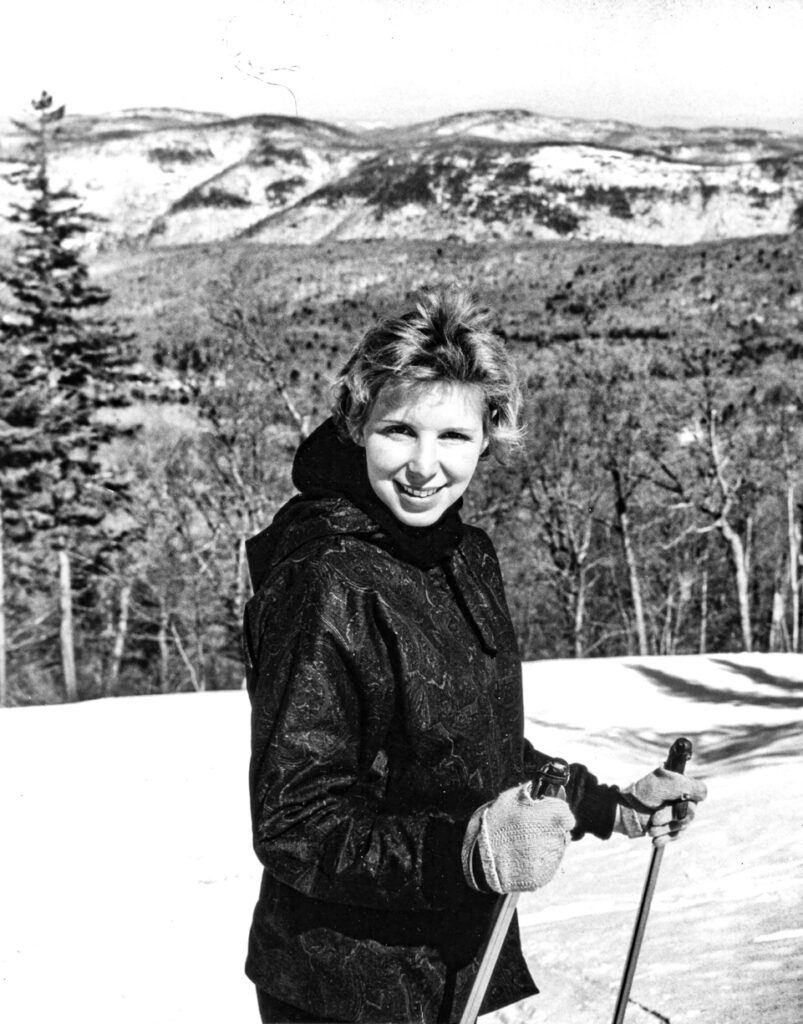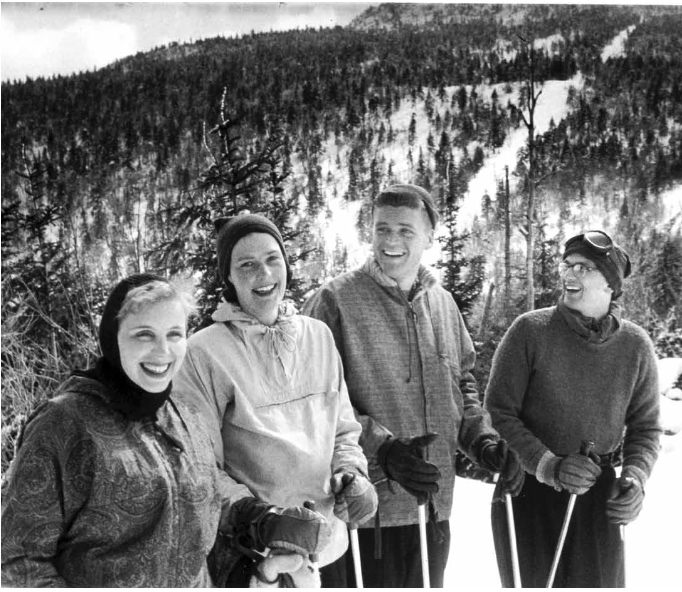By Karen D. Lorentz
One of the things that made Killington unique was the input and work of women from the get-go.
The 1950s were the era when ski area development and management were the province of men. Few wives of founders participated in decision-making, let alone were incorporators, directors, and officers of the parent company, and also worked tirelessly for a ski area to open!
Sue Smith did. She shared and worked for the vision of Killington her entire adult life.
Susanne “Sue” H. Smith was born in Vienna, Austria in 1933. Her parents, Otto and Maria Anna Hahn, fled Austria and a Europe on the brink of World War II in 1938. In 1980 interviews, Sue recalled her parents’ struggles and the many difficulties they encountered in establishing a new life in the United States.
“In retrospect, my early years influenced and prepared me for life as it was to unfold. I emerged from these formative years with the belief that the opportunities to pursue the American Dream existed and that all things were possible through hard work and tenacity.
“When Pres and I embarked on the Killington venture, it never occurred to me that success might elude us.”
Sue had become enthused about learning to ski as a teenager when she had her first lesson on a nearby Yale University’s golf course. It wasn’t until she attended the University of Connecticut that she took her first trip to the mountains on a college outing club visit to Mad River Glen.
When Sue’s father died suddenly in 1953, she was forced to leave college, but a desire for travel and adventure had already established her career plan. Due to her fluency in foreign languages, Pan American Airlines promised her a flight attendant position on bilingual international routes when she turned 21. In the interim, she began working as a Yale University health department secretary.
She met Pres Smith in 1954 at the Connecticut shore. When he proposed, Sue “had to make a very conscious decision between the lure of seeing the world with Pan Am and the prospect of marriage and an unknown future in Vermont.”
Although she never thought of the Vermont venture as pioneering, she did regard it “as an exciting and adventurous opportunity to share a life together.”
Early contributions, support
After their marriage at the Yale University Chapel in April of 1955, the couple took a ski honeymoon at Stowe, an experience that cemented the dream of developing a ski area.
While Pres and his uncle Preston Leete intensified their efforts to make further studies of Killington’s potential, Sue had returned to her job at Yale. She was the sole wage earner, and at $120 a month, funds were less than plentiful!
Another expedition to Killington in mid-May 1955 convinced them that this was the mountain to develop.
In the summer of 1956, Sue joined Pres in Vermont. She found employment in Rockingham, and they moved in with his grandmother May Minor Leete. Sue remembered her as “an extraordinary woman who moved to Vermont at age 85 and fostered our continued perseverance and helped us overcome some difficult hurdles. She lived to be 104 years old and saw the dream become a reality.”
With spare time access to a typewriter and mimeograph machine, Sue cranked out letters and other communications, extolling the virtues of developing Killington. Armed with her “homemade” but impressive prospectus on the Sherburne Corporation’s plans to develop Killington Mountain, Pres Smith pursued investors in Connecticut, Massachusetts, New Hampshire, and Vermont during the spring and summer of 1956.
Looking back, Sue said, “The direction our lives took was implemented not only by our own fervor and commitment, but the timing was right. During the late 1950s, many more Americans were ready to rediscover the mountains for recreation — this time through the sport of skiing. We caught the wave and rode the crest.”
First home and office
On their early trips into Killington, the Smiths had met Oren Bates, a Sherburne selectman and representative to the Vermont Legislature.
Excited about the future he saw for the town, Bates allowed the young couple to stay at the old Bates family farmhouse, long since abandoned but the closest dwelling to the mountain.
The Sherburne Corporation bought the Bates farmhouse in November 1956 along with what was thought to be 50 acres (about 70 surveyed acres).
The circa 1860 farmhouse was a primitive affair, lacking electricity, central heat, and insulation.
Walter Morrison recalled, “Some of us wanted to burn it down, but I think it was Pres who said let’s clean it out and see if we can’t save it.”
Camping out on the lawn, the early directors did just that. With the milk shed made habitable, the Smiths lived there until the main part of the house was fixed up. [Smith killed 23 porcupines in a month’s time inside the house that winter.]
Sargent recalled “the surprised look on Sue Smith’s face the day that Pres walked into the living room with a chainsaw. He cut a hole in the floor for heat to come up from the furnace that we had just installed.”
The unpretentious farmhouse became a hub of activity in 1957, serving as home to the Smiths and lodge to the Sargents, Morrisons, and whoever else happened to come up to help carve a work road to the mountain or clear the first ski trails and lift lines.
The farmhouse also served as the first office for the Sherburne Corporation. Sue had recalled, “It wasn’t exactly impressive. Once a man came to see about employment and was shown into the combination home and office. The children were being readied for bed, and a naked baby crawled into the room, and then the mud-caked men, returning from work on the mountain, began to strip.”
She laughed as she recalled that Hans Thorner never came back. Had he been more favorably impressed with the Killington operation, the Swiss ski instructor might never have gone on to found Magic Mountain in Londonderry, Vermont.
A great first lady

Sue Smith was an impressive promoter for the Killington project and a talented and outgoing hostess who could graciously manage home, children, and business details simultaneously.
Sue Smith continued to play a significant and varied role in the development of Killington. She supported the vision both conceptually and practically, sharing the vision and serving as the sole wage earner until Killington got off the ground.
While Pres was busy cutting trails or installing lifts, she took the phone calls and handled myriad business details, including stock purchases and transfers. Even after the mountain was open for skiing, she continued to host the many potential investors Smith would bring home.
Sue was indispensable in helping to launch Killington. She stocked the first ski shop, did the bookkeeping chores, served food in the base lodge, and when someone ran out of supplies or needed a chainsaw fixed, she ran those errands.
She began the first “lodging bureau,” operating it out of the farmhouse with part-time help, and was instrumental in the formation of the Killington Ski Club. She also served on community boards and committees and often accompanied her children on the racing circuit in the United States and Europe.
An incorporator of the Sherburne Corporation, Sue served as a board director and secretary and as corporate secretary from 1956 until her death in 1995. In this capacity, she oversaw stockholder-related matters and details for the all-important annual meetings.
An avid skier and world traveler, she was interested in guiding the direction of Killington’s future, and through her active participation, she contributed to the direction of the ski area and ski company. She was one of Vermont’s great pioneering “first ladies” of ski area development and the longest at 40 years of service.
Mary T. Sargent, wife of Joe Sargent, was another of the five original incorporators and board members of the Sherburne Corporation. Like Sue Smith, she helped Killington through her graciousness as a hostess and her promotional work on behalf of the new venture. An avid skier and mother of four, she remained active on the Board of Directors until the company’s sale in 1996, bringing another perspective to its decision-making process.
One example of the significant influence these two women had on Killington’s development occurred when they nixed their husbands’ suggestion to construct the Snowshed Lodge at the top of Snowshed versus the base. The ladies prevailed, noting it would be impractical with the parking area down below!
Next week we’ll explore the Catch-22 situation and continued perseverance that helped the founders overcome some difficult hurdles and finally open Killington.




